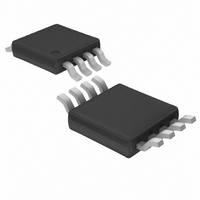LTC1877EMS8#TR Linear Technology, LTC1877EMS8#TR Datasheet - Page 9

LTC1877EMS8#TR
Manufacturer Part Number
LTC1877EMS8#TR
Description
IC BUCK SYNC ADJ .6A 8MSOP
Manufacturer
Linear Technology
Type
Step-Down (Buck)r
Datasheet
1.LTC1877EMS8PBF.pdf
(16 pages)
Specifications of LTC1877EMS8#TR
Internal Switch(s)
Yes
Synchronous Rectifier
Yes
Number Of Outputs
1
Voltage - Output
0.8 ~ 10 V
Current - Output
600mA
Frequency - Switching
550kHz
Voltage - Input
2.65 ~ 10 V
Operating Temperature
-40°C ~ 85°C
Mounting Type
Surface Mount
Package / Case
8-MSOP, Micro8™, 8-uMAX, 8-uSOP,
Lead Free Status / RoHS Status
Contains lead / RoHS non-compliant
Power - Output
-
Available stocks
Company
Part Number
Manufacturer
Quantity
Price
Accepting larger values of ΔI
ductance, but results in higher output voltage ripple and
greater core losses. A reasonable starting point for setting
ripple current is ΔI
The inductor value also has an effect on Burst Mode opera-
tion. The transition to low current operation begins when
the inductor current peaks fall to approximately 250mA.
Lower inductor values (higher ΔI
at lower load currents, which can cause a dip in effi ciency
in the upper range of low current operation. In Burst Mode
operation, lower inductance values will cause the burst
frequency to increase.
Inductor Core Selection
Once the value for L is known, the type of inductor must
be selected. High effi ciency converters generally cannot
afford the core loss found in low cost powdered iron cores,
forcing the use of more expensive ferrite, molypermalloy,
or Kool Mμ cores. Actual core loss is independent of core
size for a fi xed inductor value, but it is very dependent
on inductance selected. As inductance increases, core
losses go down. Unfortunately, increased inductance
requires more turns of wire and therefore copper losses
will increase.
Ferrite designs have very low core losses and are pre-
ferred at high switching frequencies, so design goals can
concentrate on copper loss and preventing saturation.
Ferrite core material saturates hard, which means that
inductance collapses abruptly when the peak design current
is exceeded. This results in an abrupt increase in inductor
ripple current and consequent output voltage ripple. Do
not allow the core to saturate!
Kool Mμ (from Magnetics, Inc.) is a very good, low loss core
material for toroids with a soft saturation characteristic.
Molypermalloy is slightly more effi cient at high (>200kHz)
switching frequencies but quite a bit more expensive. To-
roids are very space effi cient, especially when you can use
several layers of wire, while inductors wound on bobbins
are generally easier to surface mount. New designs for
surface mount inductors are available from Coiltronics,
Coilcraft, Dale and Sumida.
APPLICATIONS INFORMATION
L
= 0.4(I
MAX
L
).
allows the use of low in-
L
) will cause this to occur
C
In continuous mode, the source current of the top MOSFET
is a square wave of duty cycle V
voltage transients, a low ESR input capacitor sized for the
maximum RMS current must be used. The maximum RMS
capacitor current is given by:
This formula has a maximum at V
= I
used for design because even signifi cant deviations do
not offer much relief. Note the capacitor manufacturer’s
ripple current ratings are often based on 2000 hours of
life. This makes it advisable to further derate the capacitor,
or choose a capacitor rated at a higher temperature than
required. Several capacitors may also be paralleled to meet
size or height requirements in the design. Always consult
the manufacturer if there is any question.
The selection of C
series resistance (ESR). Typically, once the ESR require-
ment is satisfi ed, the capacitance is adequate for fi ltering.
The output ripple ΔV
where f = operating frequency, C
and ΔI
is highest at maximum input voltage since ΔI
with input voltage. For the LTC1877, the general rule for
proper operation is:
The choice of using a smaller output capacitance increases
the output ripple voltage due to the frequency dependent
term but can be compensated for by using capacitor(s) of
very low ESR to maintain low ripple voltage. The I
compensation components can be optimized to provide
stable high performance transient response regardless of
the output capacitor selected.
ESR is a direct function of the volume of the capacitor.
Manufacturers such as Taiyo Yuden, AVX, Sprague, Kemet
and Sanyo should be considered for high performance ca-
IN
OUT
C
C
Δ
and C
OUT
IN
V
OUT
/2. This simple worst-case condition is commonly
L
required I
= ripple current in the inductor. The output ripple
required ESR < 0.25Ω
OUT
≅ Δ
Selection
I ESR
L
⎛
⎜
⎝
RMS
OUT
OUT
≅
is driven by the required effective
+
I
OMAX
is determined by:
8
fC
1
OUT
[
V
OUT
OUT
OUT
⎞
⎟
⎠
IN
/V
= output capacitance
= 2V
(
IN
V
IN
LTC1877
. To prevent large
V
OUT
−
IN
V
, where I
OUT
L
increases
)
]
1 2 /
TH
1877fa
RMS
9
pin













